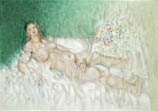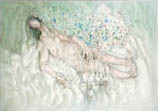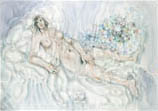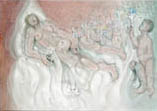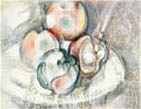exhibition programme | paintings | tapestries | prints | chronology of a life | market | biography & bibliography | agents | news | contact
Homage to his Masters (2005 - 2006)
'Louis le Brocquy and Gimpel Fils (Gallery) have been together for sixty years. Such an extended arch of time and brotherhood is celebrated at Gimpel Fils by this exhibition of a group of new paintings by le Brocquy, now aged ninety, which pay homage to those among whom the artist calls his Masters Rembrandt, Velazquez, Goya, Manet and Cézanne. The primary impact of the exhibition comes in a series of Odalisques, four large paintings, each 114 x 162 cm, made in a sequence from around the summer of 2005 until summer 2006. They are inspired by Manet's painting Olympia (1863), a masterpiece which le Brocquy has ruminated upon since he first encountered it in Paris in 1938 at the Jeu de Paume. Olympia worked her complicated magic on le Brocquy at intervals throughout his career, while also leaving her enduring mark on art history and on the work of many other great artists including Picasso, Modigliani and Moore. In 1951 le Brocquy perceived Olympia very differently in his large painting A Family (National Gallery of Ireland), envisaging a group of refugees in post-war Europe. Here Manet's cool sensuality has been completely ignored; as the artist puts it, 'reduced to Palaeolithic circumstance under electric light bulbs.' In the recent Odalisques, however, le Brocquy has wholly returned to his original delight in Olympia, a naked figure at once aloof and alluring.' ... | READ CHRONOLOGY OF A LIFE: HOMAGE TO HIS MASTERS
1. Mick Wilson. Le Brocquy: To look, and then to look again, once more | 2. Louis le Brocquy. Artist's Note
The figure in le Brocquy's Odalisques conjures a sequence of moods, conveyed through colour variations and amendments of pose and staffage woman, cat, boy, flowers. Odalisque 1 is alert, lying naked on her bed against a modulated rich green background. Her fingers are in sensitive tactile motion, suggested by filmy, equivocal paintwork, and the flower bunch by her left leg makes a painterly burst of red, blue, white and yellow. She has a wide-awake erotic charge, the ripples playing across the picture surface suggesting that she may be lying not on a bed, but in the shallow end of a warm, inviting swimming-pool. Odalisque 2, the most overtly sexual of the group, is fast asleep and, with her elongated neck and thrown back head, evidently dreams with flowers that are now not a bunch, but a river flowing luxuriously around her. In Odalisque 3 we see an explosion of summer flowers. The woman is sitting upright, awake and aware, with intense green eyes looking slightly to the left of the viewer; the cat sleeps. The last of the quartet, Odalisque 4, is asleep, and visited by a small naked boy who gives her flowers. The cat beside her is quietly watchful. There is a voluptuous pink tonality here, the body and bedclothes interpenetrating, and the whole articulated by gauzy red and pink flowing crayon marks. Fluid lines circle round and round to create, gently and lovingly, the form of legs, arms and breasts.
Although he began with Manet's Olympia as the source, le Brocquy moves outwards in the Odalisques through his own experience as a painter, drawing on a reservoir of insight accumulated over a lifetime. The ripples which unify the Odalisque canvases, and mingle image and background, are continuations of the meandering lines which the young le Brocquy made in pencil and pastel drawings of lovers in 1943 and 1944. There is a clear thread joining le Brocquy's early work to these late statements, whose line can be traced more or less clearly as it dips and rises, sharpens and softens, across the intervening sixty or seventy years.
The power in the Odalisques, when shown or reproduced as a group, comes from the rehearsal and restatement of their theme, just as a theme in music may be repeated with variations across the breadth of the orchestra. Although we expect to have another decade at least of le Brocquy's work to celebrate, this exhibition could be read as a triumphal reworking at the symphony's close of a phrase introduced in the first movement. When painting another of his persistent themes, the head image of W. B. Yeats, le Brocquy came to understand the potency of the continued sequence:
'it was then I realised that a portrait can no longer be the stable, pillared entity of Renaissance vision that the portrait in our time can have no visual finality.'
Restatement, whether in art or music, is renewal.
The titles of the eight paintings shown here have as their common prefix 'Looking at' Looking at Manet, Velazquez, Goya, Cézanne. They began as 'Homage to' these Masters, but le Brocquy's vision and translation of his models is so searching, that he invites us not so much to pay homage, but, as he has done all his life, to look at them again and again. Thus, through le Brocquy's brush, we meet once again Velazquez' Don Sebastian de Mora and Goya's Doña Antonia Zárate, we revisit the Villa Medici in the footsteps of Velazquez, and we encounter, once again, four ordinary apples and a knife that were first presented to us by Cézanne.
James Hamilton, 2006
In 1945 Charles Gimpel visited Ireland along with his incomparable wife Kay. Charles told me he was impressed by my paintings and suggested that I should come to London, which I did in the following year. In Charles I found a friend who believed in and promoted my work, notably in its inclusion within successive exhibitions organised by the Arts and British Councils in the UK and overseas. I was fortunate in my experience of London during the late Forties and Fifties. For this experience I have always felt deeply indebted to dear Charles Gimpel In London I could again - as in 1938 - look at those Masters who had originally prompted me as a painter: Rembrandt, Velazquez, and Goya as well as making further 'discoveries' such as Giacometti, Picasso's cubism and - reflectively - to Velazquez' forerunner, Caravaggio. Paintings by Manet and Cézanne endured in my mind, however, as is evident in the present exhibition in which I have tried to reflect something of the subjective process of looking in relation to such great works of art as Manet's Olympia. I was, in fact, first preoccupied by Olympia in 1950-51, when I painted A Family (National Gallery of Ireland) in which the cool sensuality of Manet's great composition has been ironically transformed, envisaging refugees during the post-war period The reclining female figure in A Family assumes a very different aspect. to that of Victorine Meurend in Olympia. The man, replacing Manet's black servant sits alone. The bouquet is reduced to a mere wisp held by a child. The black cat becomes white, ominously emerging from the sheets. Here is a human condition, stripped back to Palaeolithic circumstance under an electric light bulb. On the contrary, the four Odalisque paintings shown here return to the sensuous joy I experienced in 1938 when looking at this very great painting by Edouard Manet. After Charles' tragically premature death in January 1973, I continued my allegiance to Gimpel Fils with the friendship and support of Peter, Kay and Catherine. This, in turn, was followed by the constant encouragement I now receive from Charles' son, René, who - I am both proud and grateful to say - has thus completed my association with this great London Gallery to a full sixty years. In all of this I include my own son, Pierre, who for some ten years has become the mainstay of my work. What moves me most is Pierre's belief in my painting (reflecting that of Charles himself), a belief which Pierre is clearly determined to make perceptible to a wider world.
Louis le Brocquy, 2006
